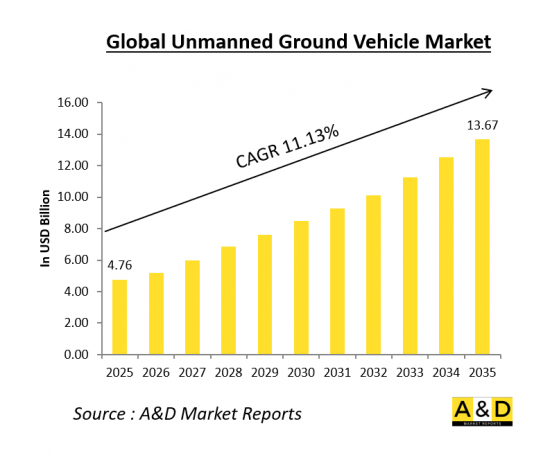PUBLISHER: Aviation & Defense Market Reports (A&D) | PRODUCT CODE: 1664198

PUBLISHER: Aviation & Defense Market Reports (A&D) | PRODUCT CODE: 1664198
Global Unmanned Ground Vehicles Market 2025-2035
The global market for unmanned ground vehicles (UGVs) is projected to grow from USD 4.76 billion in 2025 to USD 13.67 billion by 2035, with a Compound Annual Growth Rate (CAGR) of 11.13% during the forecast period. UGVs are set to play a crucial role across various industries, including defense, security, agriculture, and logistics. This rapid expansion is driven by the increasing adoption of UGVs for applications such as reconnaissance, surveillance, explosive ordnance disposal (EOD), and autonomous transportation. Technological advancements in artificial intelligence, sensor systems, and robotics are further propelling market growth, enabling UGVs to operate effectively in complex and hazardous environments. As industries recognize the advantages of UGVs in improving operational efficiency, reducing costs, and enhancing safety, demand for these unmanned platforms is expected to surge, solidifying their importance in modern operations.

Introduction to Unmanned Ground Vehicle (UGV) Market:
The Unmanned Ground Vehicle (UGV) market has experienced rapid growth in recent years, driven by advancements in robotics, artificial intelligence, and defense applications. UGVs are autonomous or remotely controlled land-based vehicles used for a variety of military, commercial, and industrial purposes. These systems play a crucial role in modern combat, surveillance, logistics, and hazardous material handling, reducing the need for direct human intervention in dangerous environments. The increasing demand for automation, coupled with evolving defense strategies, has positioned UGVs as essential assets in multiple sectors.
The defense sector remains the primary driver of UGV development, with military forces worldwide integrating these systems for reconnaissance, explosive ordnance disposal (EOD), and combat support. Meanwhile, commercial applications, including agriculture, logistics, and mining, are also fueling market expansion. As technological innovation continues, the market for UGVs is expected to witness substantial growth, driven by increasing investments in autonomous mobility and sensor integration.
Technology Impact in Unmanned Ground Vehicle Market:
Technological advancements have played a pivotal role in shaping the capabilities and applications of UGVs. Key innovations include artificial intelligence (AI), machine learning, sensor fusion, and advanced communication systems. These technologies enable autonomous navigation, obstacle detection, and real-time data transmission, enhancing operational efficiency and reducing human involvement in high-risk scenarios.
Artificial Intelligence and Machine Learning: AI-powered UGVs can analyze vast amounts of data in real-time, improving decision-making capabilities in dynamic environments. Machine learning algorithms help in adaptive navigation, terrain recognition, and threat assessment.
Sensor Integration: The incorporation of LiDAR, infrared cameras, and ultrasonic sensors allows UGVs to detect and avoid obstacles autonomously. These sensors also improve target identification and environmental awareness in combat and industrial operations.
Autonomous Navigation: GPS-denied navigation and simultaneous localization and mapping (SLAM) technologies enhance UGV mobility in complex terrains. These systems are crucial for military applications where GPS signals may be disrupted.
Communication and Network Connectivity: UGVs rely on secure data links and real-time connectivity to operate effectively in the field. Advanced encryption and low-latency communication networks enable seamless coordination between multiple units.
Robust Battery and Energy Management: The development of high-capacity batteries and hybrid power solutions has extended the operational endurance of UGVs. Energy-efficient propulsion systems are enhancing their capability to perform extended missions without frequent recharging.
The integration of these cutting-edge technologies is transforming UGVs into highly capable assets, allowing them to perform complex missions with minimal human intervention.
Key Drivers in Unmanned Ground Vehicle Market:
Several factors are propelling the growth of the UGV market, with the defense sector leading the demand. However, commercial and industrial applications are also expanding due to advancements in automation and robotics. Key drivers include:
Regional Trends in Unmanned Ground Vehicle Market:
The UGV market is experiencing significant growth across different regions, with various countries investing in autonomous ground vehicle technology for defense and commercial applications. Key regional trends include:
Table of Contents
Unmanned Ground Vehicles Market Report Definition
Unmanned Ground Vehicles Market Segmentation
By Region
By Application
By Mode of Operation
Unmanned Ground Vehicles Market Analysis for next 10 Years
The 10-year unmanned ground vehicles market analysis would give a detailed overview of unmanned ground vehicles market growth, changing dynamics, technology adoption overviews and the overall market attractiveness is covered in this chapter.
Market Technologies of Unmanned Ground Vehicles Market
This segment covers the top 10 technologies that is expected to impact this market and the possible implications these technologies would have on the overall market.
Global Unmanned Ground Vehicles Market Forecast
The 10-year unmanned ground vehicles market forecast of this market is covered in detailed across the segments which are mentioned above.
Regional Unmanned Ground Vehicles Market Trends & Forecast
The regional unmanned ground vehicles market trends, drivers, restraints and Challenges of this market, the Political, Economic, Social and Technology aspects are covered in this segment. The market forecast and scenario analysis across regions are also covered in detailed in this segment. The last part of the regional analysis includes profiling of the key companies, supplier landscape and company benchmarking. The current market size is estimated based on the normal scenario.
List of Tables
- Table 1: 10 Year Market Outlook, 2025-2035
- Table 2: Drivers, Impact Analysis, North America
- Table 3: Restraints, Impact Analysis, North America
- Table 4: Challenges, Impact Analysis, North America
- Table 5: Drivers, Impact Analysis, Europe
- Table 6: Restraints, Impact Analysis, Europe
List of Figures




